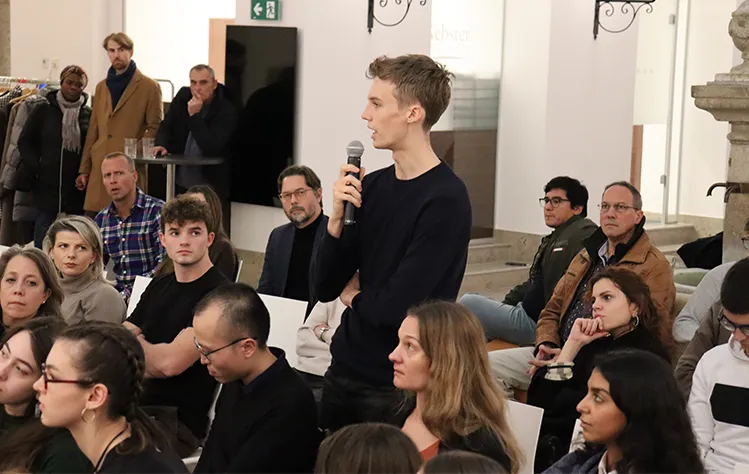Research at Webster Vienna
Greener Plates, Stronger Futures: Sustainability in Vienna’s Restaurant Scene
Although sustainability has become a critical concern for the global hospitality industry, limited research has focused on how restaurants in Vienna specifically adopt and maintain sustainable practices in response to increasing consumer demand, regulatory pressures, and broader societal concern over climate change. Addressing this gap, Sofiia Yesaulova completed her MBA thesis at Webster Vienna Private University under the supervision of Dr. Pernille Eskerod. Her research examined the environmental, economic, and social dimensions of sustainability within the Viennese dining sector, providing a comparative analysis of restaurants that have integrated sustainable operations into their daily practices.
The study investigated both the barriers to sustainable transformation—such as high
implementation costs, supply chain limitations, and evolving consumer expectations—and
the incentives that drive restaurants toward environmentally responsible models. By
situating the analysis in the Viennese urban context, the research extends understanding
of ethical restaurant management and contributes to broader debates on sustainable
business practices in service industries.
Findings not only underscore the challenges of embedding sustainability into restaurant
operations but also highlight opportunities for innovation, competitive advantage,
and long-term viability.
The study further offers practical recommendations for managers, owners, policymakers, and consumers, emphasizing sustainability as an increasingly indispensable element of restaurant strategy in light of global environmental pressures and shifting consumer preferences.
Finance, Innovation, and Growth: Rethinking the Too-Much-Finance Debate
Although financial development has long been viewed as a key engine of growth, recent evidence suggests that its benefits may diminish beyond a certain point. Addressing this debate, Alessandra Flöck completed her MBA thesis at Webster Vienna Private University under the supervision of Dr. Menbere Workie, examining the moderating role of innovation. Innovation was proxied by research and development (R&D) expenditure, treated as a key form of investment that reshapes how finance translates into growth. While conventional theory underscores finance as a driver of economic expansion, more recent studies point to a “too-much-finance” effect, where excessive financial deepening may hinder growth. Flöck’s analysis investigated whether financial development fosters growth and whether the presence of R&D modifies this relationship.
Using a panel dataset of developed and developing countries covering the period 1990–2020, the study applied fixed effects regression models incorporating both interaction and non-linear terms. The results revealed mixed effects of financial development—measured by bank assets, private credit, and stock market capitalization—on economic growth. However, when considered jointly with R&D investment, the relationship became significantly more favorable, indicating that innovation strengthens the finance–growth nexus. Robustness checks using higher-quality subsamples supported these findings, although limitations in data availability and proxy measures constrain the generalizability of the conclusions.
Overall, the study highlights that the benefits of financial development depend not only on the depth of financial systems but also on a country’s innovation capacity, which shapes long-term growth trajectories.
Faculty — Business and Management
Faculty and Staff
Active in 2020-2021
Prof. Bátora from the IR Department published a research article in the European Journal of International Relations

In a new research article entitled "Repositioning of war: the ambiguous language of private military and security companies," Prof. Jozef Bátora (IR Department) and his co-author Dr. Michal Ovádek (Department of Political Science, University College London) argue that war as an institution of the modern state order is repositioned by the ambiguous language used by private military and security companies (PMSCs).
They suggest that to gain an analytical understanding of the ongoing repositioning of war as an institution, it is useful to study the language and discursive practices of PMSCs. This includes capturing the emergence of new recombined vocabularies connecting PMSCs to multiple societal domains usually unrelated to war. To do so, their theoretical approach builds on new institutionalism in political science and on organizational discourse analysis, and they analyze terminology on the websites of PMSCs cooperating with the European Union (EU).
Based on data from a new survey of 564 PMSCs connected with the EU, Bátora and Ovádek generated a corpus of text retrieved from 22,000 webpages. To identify core themes in PMSC discourse, they use principal component analysis (PCA) and non-negative matrix factorization (NMF) and perform topic classification and dimensionality reduction, and show patterns of recombined vocabularies across multiple domains.
They complement this by illustrating PMSCs' recombined practices in the field, demonstrating that language-based repositioning of war is also complemented by its practice-based repositioning. Bátora and Ovádek suggest that the concept of repositioning is useful as a new way of theorizing institutional change.
Faculty — International Relations
Faculty and Staff
Active in 2020-2021
Methods of Political Inquiry
Advanced Research Methods
elinabrutschin60@webster.edu
Middle East Area Studies
Globalization
War and Diplomacy
The Age of Total War: Europe 1890-1945
Contemporary Europe: 1945-Present
dieterreinisch07@webster.edu
International Law
Webster Vienna Professor Publishes Groundbreaking Research on Political Memes in New
Media & Society
Dr. Bradley E. Wiggins, Associate Professor and Department Head of Media Communications
at Webster Vienna Private University, together with co-author Prof. Maria Madlberger,
has published a new study in New Media & Society, one of the most highly ranked journals
in the field of media and communication.
The article, titled “Memetic Election Cycles in US Presidential Campaigns”, examines
how internet memes have transformed into powerful political tools in U.S. elections,
particularly since the 2016 campaign.
Drawing from research in political communication, participatory culture, and digital marketing, the study demonstrates how memes operate as more than viral jokes: they have evolved into vehicles of voter engagement, branding, and persuasion. The authors show that political campaigns increasingly use memes not only to energize grassroots support but also to shape public perception in an era of deepening political polarization.
The study highlights both the opportunities and risks of this digital phenomenon. On the one hand, memes function as hybrid forms of digital folklore and viral marketing, amplifying political messages far beyond traditional campaign strategies. On the other hand, their rapid spread makes them fertile ground for misinformation and disinformation, with tangible influence on voter attitudes and behavior.
“Memes have become central to how political discourse unfolds online,” notes Dr. Wiggins. “They blur the lines between grassroots culture and professional marketing, and their influence on elections is only likely to grow.”
The article adds to Dr. Wiggins’ extensive scholarship on digital culture and political communication. As a member of the editorial board of New Media & Society, his contribution further cements Webster Vienna’s role at the forefront of international media and communications research.
Reference: Wiggins, B. E., & Madlberger, M. (2025). Memetic Election Cycles in US Presidential Campaigns. New Media & Society.
Faculty — Strategic Communication
Faculty and Staff
Active in 2020–2021
A Study on The Influences of Culture and Linguistic Diversity on Perceived Stress
As a recent graduate of Webster Vienna Private University’s Master of Arts in Psychology with an Emphasis in Counselling program, Lina Mansour has recently completed her master’s thesis on “The Influences of Culture and Linguistic Diversity on Perceived Stress”. Her study aims to investigate the interplay between perceived culture, from the aspect of individualism and collectivism, as well as linguistic diversity as variables that influence stress outcomes in individuals.
Mansour’s study consisted of a total of 167 participants, 113 of which were multilingual and 54 were monolingual. Participants’ answers were quantitative data collected with using the Perceived Stress Scale (PSS), Individualism and Collectivism Scale (IND-COL), and a modified version of the LEAP-Q questionnaire. In addition, qualitative data was collected from 8 semi-structured interviews, showing different ways multilingual participants cope, adapt, and navigate cultural expectations.
The results indicate that participants who identified with collectivistic cultures reported lower levels of perceived stress than those from individualistic cultures. However, no significant differences were observed in perceived stress levels between monolinguals and multilinguals, nor in the interaction between linguistic diversity and perceived culture. This study highlights the importance of further exploring the dynamics of language diversity and cultural orientation on perceived stress.
Faculty — Psychology
Faculty and Staff
Active in 2020-2021
Social Psychology & Occupational Health
Learn More
Founded in 1915, Webster is an independent nonprofit university with students studying at campus locations in North America, Europe and Asia, and in a robust online learning environment. With its main campus in St. Louis, Missouri, USA, Webster University’s network of faculty, staff, students and alumni forge powerful bonds with each other and their communities around the globe. The University is committed to engaged learning experiences and empowering our students to become catalysts for change. Prepare for your next step and explore our community resources.
Highlights from Webster Vienna
Global Student Leadership Summit Empowers Students to Lead Across Borders
May 27, 2025
From May 18 to 23, a group of 23 undergraduate student leaders from across the Webster global network gathered at the...

In the News - Enrollment, Blazer, Rosenblum, Wiggins, Belo, Bruce, Stewart, Smith, AuBuchon and Alumni
December 5, 2024

US Election Results and Global Impacts: Expert Reflections at Webster Vienna
December 3, 2024
